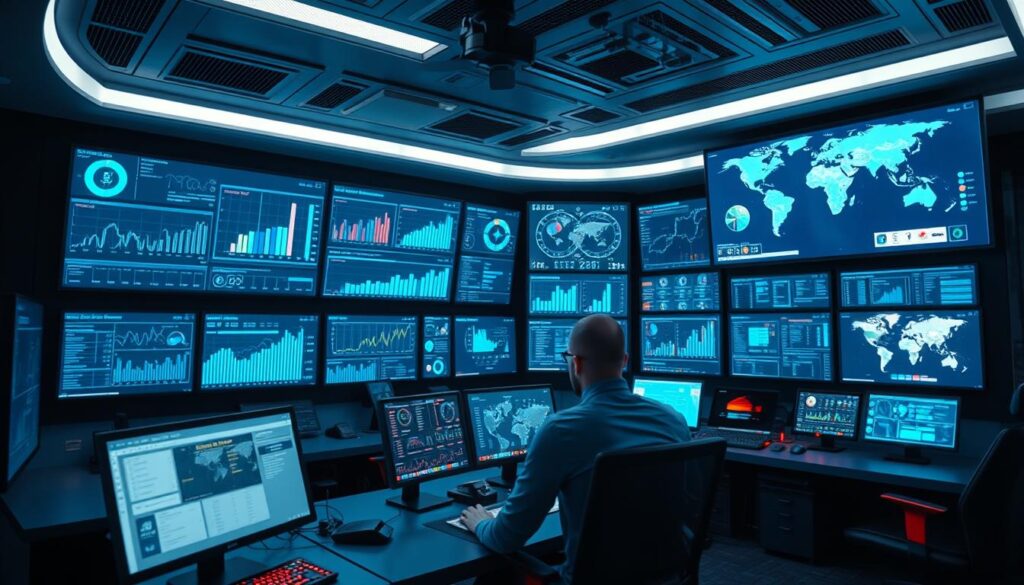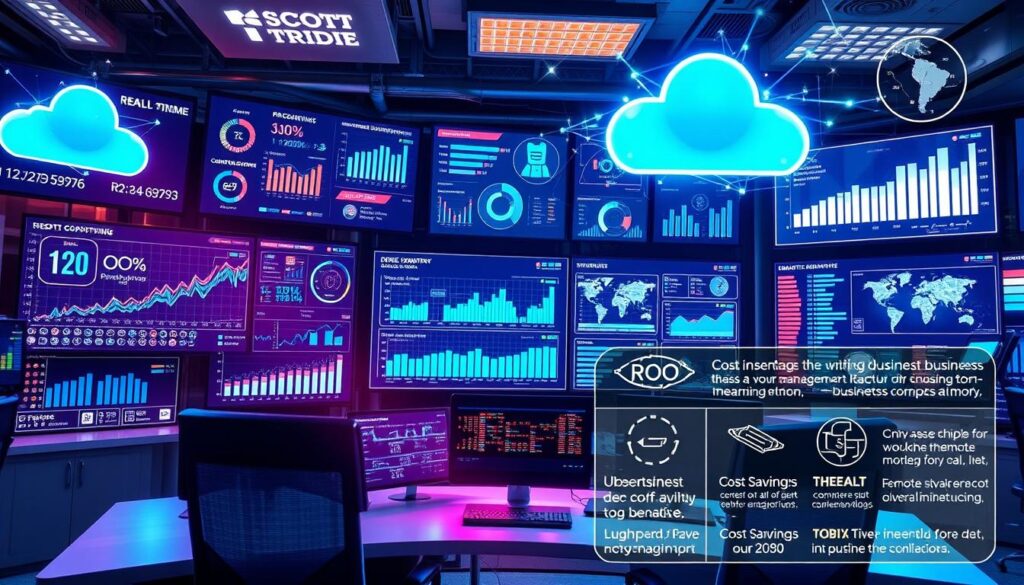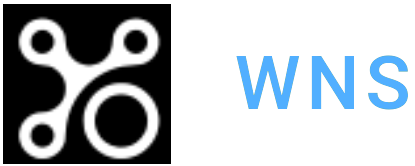Remote monitoring lets businesses check their systems and networks from anywhere. It’s great for network engineers who manage sites far away. This tech brings many benefits, like more work done, less money spent, and better security.
With remote monitoring, companies can fix problems fast. This means less time when things aren’t working right. It also makes work more efficient.
Recent stats show that remote monitoring cuts downtime a lot. It can make fixing problems 70% faster. Businesses see their networks up and running 30% more often. And, staff gets 40% more done because they don’t have to travel as much.
IT teams can tackle network problems right away, no matter where they are. This saves about 15 hours of trouble-shooting per issue. Over 80 staff at The University of British Columbia’s Fraser Medical Program use remote monitoring. They get live updates on how their network is doing.
Key Takeaways
- Remote monitoring lets businesses check their systems, networks, and devices from anywhere, at any time, using remote monitoring services.
- Remote monitoring offers numerous benefits, including increased productivity, reduced costs, and enhanced security through monitoring solutions.
- Organizations utilizing remote monitoring report an average of 30% increase in network uptime and a 40% improvement in staff productivity.
- Remote monitoring allows IT departments to respond to network issues instantly from anywhere, potentially saving an average of 15 hours of on-site troubleshooting per incident.
- Remote monitoring is a cost-effective solution that can help businesses reduce downtime, improve efficiency, and enhance security using remote monitoring services.
- Remote monitoring services can help businesses improve their overall operational efficiency and reduce costs.
Understanding Remote Monitoring in Modern Business
Remote monitoring technology is key in today’s business world. It lets companies watch their systems, networks, and devices live. This helps them fix problems before they get worse, cutting down on downtime and boosting efficiency.
Thanks to this tech, businesses can tackle issues fast. This way, they can lessen the damage caused by problems.
The tech has grown a lot, leading to better software and hardware. These tools have features like watching things live, sending alerts, and controlling things from afar. This helps companies keep their IT systems running smoothly.
Using remote monitoring, businesses can work better, save money, and offer better services. It’s a big win for them.
- Proactive issue detection and resolution
- Reduced downtime and increased system uptime
- Improved operational efficiency and cost savings
- Enhanced security and compliance
By using remote monitoring, businesses can get ahead and do better. The right software and tech help them run smoother, save money, and serve their customers better.
The Business Case for Remote Monitoring Solutions
Remote monitoring services are key for businesses today. They bring many benefits across different industries. Companies can boost their security, cut costs, and work more efficiently. For example, remote monitoring devices can be tailored to fit each business’s needs. They provide real-time data and alerts for quick action.
Ochsner Health’s TeleSitter program is a great example. It runs in 17 facilities with 108 devices for 24/7 monitoring. This program has cut fall rates and costs by 90% compared to traditional sitters. It also lets the hospital watch 12 to 16 patients per staff member, improving care and efficiency.
Remote monitoring solutions aren’t just for healthcare. Businesses in many fields can use them to better their operations, save money, and please customers. With more companies needing these services, investing in a good remote monitoring system is crucial to stay ahead.
Some main benefits of remote monitoring solutions include:
- Improved security and less risk of breaches
- Better efficiency and productivity
- Lower costs and more savings
- Real-time data and alerts for quick action
- Custom solutions to fit each business’s needs
Essential Components of Remote Monitoring Systems
Remote monitoring systems have several key parts that work together. These parts include hardware, software, network setup, and security measures. Businesses need to think about the hardware and software needed, like network devices and remote monitoring software.
The network setup is also very important. There are many options, like wired and wireless networks. Remote monitoring technology now offers many network choices. This lets businesses pick what works best for them. Security is key to keep the system safe and sound, with things like encryption and authentication.

- Real-time data collection and analysis
- Automated alerts and notifications
- Customizable dashboards and reports
- Integration with existing systems and software
These features help businesses use remote monitoring technology to get better. They can cut costs and make customers happier.
Real-Time Data Analytics and Reporting Capabilities
Real-time monitoring is key in remote services, helping businesses act fast on problems. It lets them see data as it happens, spotting trends and patterns for better decisions. Systems for remote monitoring offer tools for analyzing data in real-time, helping businesses run smoother and more efficiently.
Some main advantages of real-time data analytics are:
- Improved operational efficiency
- Enhanced decision-making capabilities
- Increased customer satisfaction
- Reduced downtime and improved predictive maintenance
Recent stats show that 90% of businesses see real-time data analytics as vital for staying ahead. Also, about 80% of companies say it boosts their efficiency.
Real-time monitoring has cut downtime by 40% in transport and other sectors. Up to 60% of makers use it to fix production problems fast. Companies with real-time analytics see a 25% drop in security breaches. They also see a 20% boost in customer happiness with tailored services.
Implementation Strategies for Remote Monitoring
Starting remote monitoring needs careful planning and assessment. First, look at your current setup and how things work. Then, pick the right software and devices for smooth communication and data sharing. It’s also key to train your staff well so they can use the system right.
The steps to start remote monitoring are clear:
- Assessment and planning: Check your current setup and find ways to get better.
- System integration: Make sure your new devices and software work well with what you already have.
- Staff training: Teach your team how to use the new system effectively.
By taking these steps, businesses can make the most of remote monitoring. It helps improve operations and cut costs. In healthcare, it also means better care and results for patients.
Cost Benefits and ROI of Remote Monitoring Services
Remote monitoring services bring many cost benefits and a good return on investment (ROI). They help lower security costs, boost efficiency, and cut downtime. Businesses can save money by using these services, with systems and devices priced differently.
The ROI from remote monitoring can be big. Businesses can get their money back through better efficiency and lower costs. For example, remote monitoring devices cut down on the need for on-site visits, saving money. Also, remote monitoring systems offer real-time data, helping businesses make smart choices and run better.
Some main cost benefits of remote monitoring services are:
- Reduced security costs
- Improved overall efficiency
- Minimized downtime
- Cost savings through reduced on-site visits
- Improved decision-making through real-time data analytics
Investing in remote monitoring services can lead to a big ROI. Businesses can see their investment pay off through better efficiency and lower costs. So, remote monitoring services are a great choice for companies wanting to improve their operations and profits.

Security and Compliance Considerations
When using remote monitoring technology, security and compliance are key. The software and devices must protect against cyber threats. Cyber risks for remote workers include malware, phishing, and Advanced Persistent Threat (APT) attacks.
Institutions should have clear policies for remote work. This includes how to handle personal networks and devices. Employees should keep work devices separate from family use and encrypt sensitive data.
Data Protection Measures
Data protection is vital for remote monitoring systems. This includes using encryption and authentication. It’s also important to follow regulations like GDPR and HIPAA.
Regulatory Requirements
Not following security regulations can lead to big fines. For example, GDPR fines can be up to 4% of global turnover. HIPAA fines can reach $1.5 million per violation. Good security practices can cut data breach risks by half.
Risk Mitigation Strategies
It’s crucial to have strategies to reduce risks in remote monitoring. This includes using strong passwords and keeping antivirus software up to date. By focusing on security, organizations can lower risks from remote monitoring technology.
Future Trends in Remote Monitoring Technology
Remote monitoring technology is changing fast. We’re seeing new remote monitoring capabilities and remote monitoring software. The tech is getting smarter, with systems and devices becoming more advanced.
Artificial intelligence and machine learning are playing bigger roles. These tools help systems understand data better. This means healthcare providers can make smarter choices and care for patients more effectively.
Some big trends in remote monitoring technology include:
- More use of mobile health technologies
- Remote patient monitoring solutions becoming more popular
- Improvements in data analytics and machine learning
Grandview Research says the remote patient monitoring market will grow by 18.5% each year until 2030. This growth is because more people want these solutions, especially in healthcare.
As remote monitoring tech keeps getting better, we’ll see even more exciting things. These new solutions will help healthcare providers give better care. They’ll also make operations more efficient and effective.
Conclusion: Transforming Your Business with Remote Monitoring
Remote monitoring solutions can change businesses in many ways. They help improve operations, security, and growth. As technology grows, we’ll see new ways to meet business needs.
Remote monitoring brings many benefits. It helps prevent downtime and cuts maintenance costs. It also helps businesses make better decisions and stay competitive.
More and more businesses are using remote monitoring. Soon, 70% of industrial businesses will be using it. This means a bright future for those looking to improve their operations and performance. By using remote monitoring, businesses can set themselves up for success and take advantage of its many benefits.

